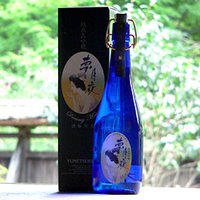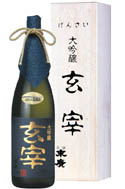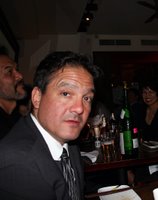 If there is one event to attend each year, make it this one as it is the biggest saké event of the year. The selection included over 300 sakés (officially 299 + few others off the list) from 146 breweries that were entered into the 2006 U.S. National Saké Appraisal, and they are divided into two rooms, one for those available in the U.S, and other for those available only in Japan. With in each room, the tables were further divided into Daiginjo A (less than Seimaibuai of 40%), Daiginjo B (Seimaibuai between 40~50%), Ginjo, Junmai, and Yamahai which included Kimoto. Each saké was served off of the official tasting cup, and attendees used eye-dropper to pour saké into their glass.
If there is one event to attend each year, make it this one as it is the biggest saké event of the year. The selection included over 300 sakés (officially 299 + few others off the list) from 146 breweries that were entered into the 2006 U.S. National Saké Appraisal, and they are divided into two rooms, one for those available in the U.S, and other for those available only in Japan. With in each room, the tables were further divided into Daiginjo A (less than Seimaibuai of 40%), Daiginjo B (Seimaibuai between 40~50%), Ginjo, Junmai, and Yamahai which included Kimoto. Each saké was served off of the official tasting cup, and attendees used eye-dropper to pour saké into their glass.The event started at 6:00pm, and lasted until 9:00pm, giving us slightly over 3 hours to taste as many sakés as possible.
 With such impressive array of selections and such short time, it was time to strategize. I opted to start with "Sakés N/A in USA," figuring that I needed to try many of the best small producers. I started in Daiginjo in the sequence as listed in the book, but after a while, decided that I'll try to look for familiar names or labels that are striking in appearance, a criteria as good as any.
With such impressive array of selections and such short time, it was time to strategize. I opted to start with "Sakés N/A in USA," figuring that I needed to try many of the best small producers. I started in Daiginjo in the sequence as listed in the book, but after a while, decided that I'll try to look for familiar names or labels that are striking in appearance, a criteria as good as any.Somewhere along the way, I felt rushed for time~ 3 hours is a short time, when there are 300+ Sakés!~ so I decided to pick up the pace. Little did I know, the first bottle I decided to skip was the one with a cute little picture of earth on the label, hardly a traditional looking saké bottle. It turned out to be Matsuokina "Tosa Uchushu" Junmai Daiginjo, the Space Saké that I knew nothing about until I came across this style while conducting a research few days after the event. What's the significance of this non-traditional saké? You can read about it here, and feel free to join me in feeling my pain.
 There were two real standouts in "Sakés N/A in USA." The first was "Kamekichi" Junmai Daiginjo (Data N/A) by Nakamura Kamekichi Shuzo (Japanese- only website) from Aomori Prefecture, with its tropical fruit flavors and good depth. The second was Shusen Eikō "Yume Tsukiyo" Junmai Daiginjo (SMV: +4, Acidity: 1.3, Rice: Matsuyamamii, Seimaibuai: 50%, Yeast: N/A) by by Eikō Shuzo (Japanese- only website) of Ehime Prefecture, with flavors of ripe Japanese nashi pears with clean and dry finish. Both those selections received Silver Medal from the Appraisal.
There were two real standouts in "Sakés N/A in USA." The first was "Kamekichi" Junmai Daiginjo (Data N/A) by Nakamura Kamekichi Shuzo (Japanese- only website) from Aomori Prefecture, with its tropical fruit flavors and good depth. The second was Shusen Eikō "Yume Tsukiyo" Junmai Daiginjo (SMV: +4, Acidity: 1.3, Rice: Matsuyamamii, Seimaibuai: 50%, Yeast: N/A) by by Eikō Shuzo (Japanese- only website) of Ehime Prefecture, with flavors of ripe Japanese nashi pears with clean and dry finish. Both those selections received Silver Medal from the Appraisal.There was one saké that I thought was a bad bottle. In the "Yamahai(Kimoto)" area, "Hakkin" by Masuichi Ichimura Shuzojo had flavors of pear, wood, musk, and cork with no discernable structure or balance. It's as if the bottle somehow went through saké's version of being "corked." That was disappointing.
 Not surprisingly, I bumped into many of my friends throughout the event, including but not limited to: Sakurai-san from Asahi Shuzo; Imada-san from Fukucho Brewery; Asami and Keiko-san of World Saké Imports; Henry Sidel and Yuno-san from Joto Saké; Kadoi-san from Sakagura; Michael John Simkin, Saké Consultant; Toshi and Tomoko of Saké Hana; Chris Johnson of Bao 111; Paul Tanguay from Sushi Samba and the winner of the 2006 Kikisakeshi Contest, NY Region; Robert Cash of Union Square Wines; Nell Rier from Aburiya Kinnosuke; and Saké Buddies Chie-san, Tim Sullivan of Urbansaké.com and Lefty (looking quite happy in the picture).
Not surprisingly, I bumped into many of my friends throughout the event, including but not limited to: Sakurai-san from Asahi Shuzo; Imada-san from Fukucho Brewery; Asami and Keiko-san of World Saké Imports; Henry Sidel and Yuno-san from Joto Saké; Kadoi-san from Sakagura; Michael John Simkin, Saké Consultant; Toshi and Tomoko of Saké Hana; Chris Johnson of Bao 111; Paul Tanguay from Sushi Samba and the winner of the 2006 Kikisakeshi Contest, NY Region; Robert Cash of Union Square Wines; Nell Rier from Aburiya Kinnosuke; and Saké Buddies Chie-san, Tim Sullivan of Urbansaké.com and Lefty (looking quite happy in the picture).The available in the US sakés were next on the list, and there were full of the names I recognized immediately. In this area, I focused on the sakés that I've never tasted before. I sought out brewers such as Born, Okunomatsu (recommended by Paul Tanguay) and Yaegaki, as sakés that I've always wanted to try like Masumi Sanka and Taiten Shiragiku "Daiginjo."
Since I drank copious amount of Japan-only sakés, and spent time socializing, my consumption of Available in US sakés were limited to Daiginjo-grade only, meaning my personal awards, applied only to Daiginjos available here:
 Gold Medal: Okunomatsu Junmai Daiginjo (SMV: +1, Acidity: 1.4, Rice: Local Rice, Seimaibuai: 40%, Yeast: Okunomatsu) from Fukushima. In a setting like this, powerful sakés tend to make expression, and Okunomatsu certainly did that. Very fruity with lush flavors of melon and strawberries, yet soft and round in every respect. Power meets elegance.
Gold Medal: Okunomatsu Junmai Daiginjo (SMV: +1, Acidity: 1.4, Rice: Local Rice, Seimaibuai: 40%, Yeast: Okunomatsu) from Fukushima. In a setting like this, powerful sakés tend to make expression, and Okunomatsu certainly did that. Very fruity with lush flavors of melon and strawberries, yet soft and round in every respect. Power meets elegance.Silver Medal: Taiten Shiragiku Daiginjo (SMV: +6, Acidity: 1.1, Rice: Yamadanishiki, Seimaibuai: 32%, Yeast: N/A) by Nariwa Ozeki Brewery from Okayama. This is a shizuku (free-run) style, showcasing very rich yet gentle mouthfeel and expressive flavors of melon and strawberries complemented by a balanced dry finish. While lot of Shizuku style is very mild, this one had a very nice expression.
 Bronze Medal: Suehiro (Japanese- only website) "Gensai" Daiginjo (SMV: +4, Acidity: 1.3, Rice: Yamadanishiki, Seimaibuai: 35%, Yeast: from Fukushima. This turned out to be a very expressive on both the nose and palate, and no wonder, it's a Genshu. For a Genshu, though, the texture was richer and soft, showing tremendous balance.
Bronze Medal: Suehiro (Japanese- only website) "Gensai" Daiginjo (SMV: +4, Acidity: 1.3, Rice: Yamadanishiki, Seimaibuai: 35%, Yeast: from Fukushima. This turned out to be a very expressive on both the nose and palate, and no wonder, it's a Genshu. For a Genshu, though, the texture was richer and soft, showing tremendous balance.Looking at the top 3, it's evident that I like saké from Fukushima, and in a mass tasting, expressive and impressionable sakés fare well.
 After The Joy of Saké event, we retreated to Puck Fair across the street for a drink, where I met John Gauntner (pic, left) who authors couple of very informative websites like this and this, and Philip Harper, a Brewmaster at Daimon/Sakahan Brewery, producer of Mukune and Tozai line of sakés, and Elise Gee, organizer of Vancouver chapter of Saké Meetup Group. After a round, we were off to Chris Johnson's Bao 111.
After The Joy of Saké event, we retreated to Puck Fair across the street for a drink, where I met John Gauntner (pic, left) who authors couple of very informative websites like this and this, and Philip Harper, a Brewmaster at Daimon/Sakahan Brewery, producer of Mukune and Tozai line of sakés, and Elise Gee, organizer of Vancouver chapter of Saké Meetup Group. After a round, we were off to Chris Johnson's Bao 111. The exact details of the meal and sakés were fuzzy. I do remember sitting at the table with Lefty, Elise, John Gauntner, Michael, and Nell (pics on right) and we got plates and plates of delicious Vietnamese cuisine, well seasoned and perfectly welcome after long night of drinking. After couple of hours of feasting and drinking, it was time for me to turn to pumpkin, as I had to get to work in about 7 hours. The best part? As I leave and settle the tab, all the saké and food comes to total of $36 ($30 + tip). Man, what a night!!!
The exact details of the meal and sakés were fuzzy. I do remember sitting at the table with Lefty, Elise, John Gauntner, Michael, and Nell (pics on right) and we got plates and plates of delicious Vietnamese cuisine, well seasoned and perfectly welcome after long night of drinking. After couple of hours of feasting and drinking, it was time for me to turn to pumpkin, as I had to get to work in about 7 hours. The best part? As I leave and settle the tab, all the saké and food comes to total of $36 ($30 + tip). Man, what a night!!!

No comments:
Post a Comment